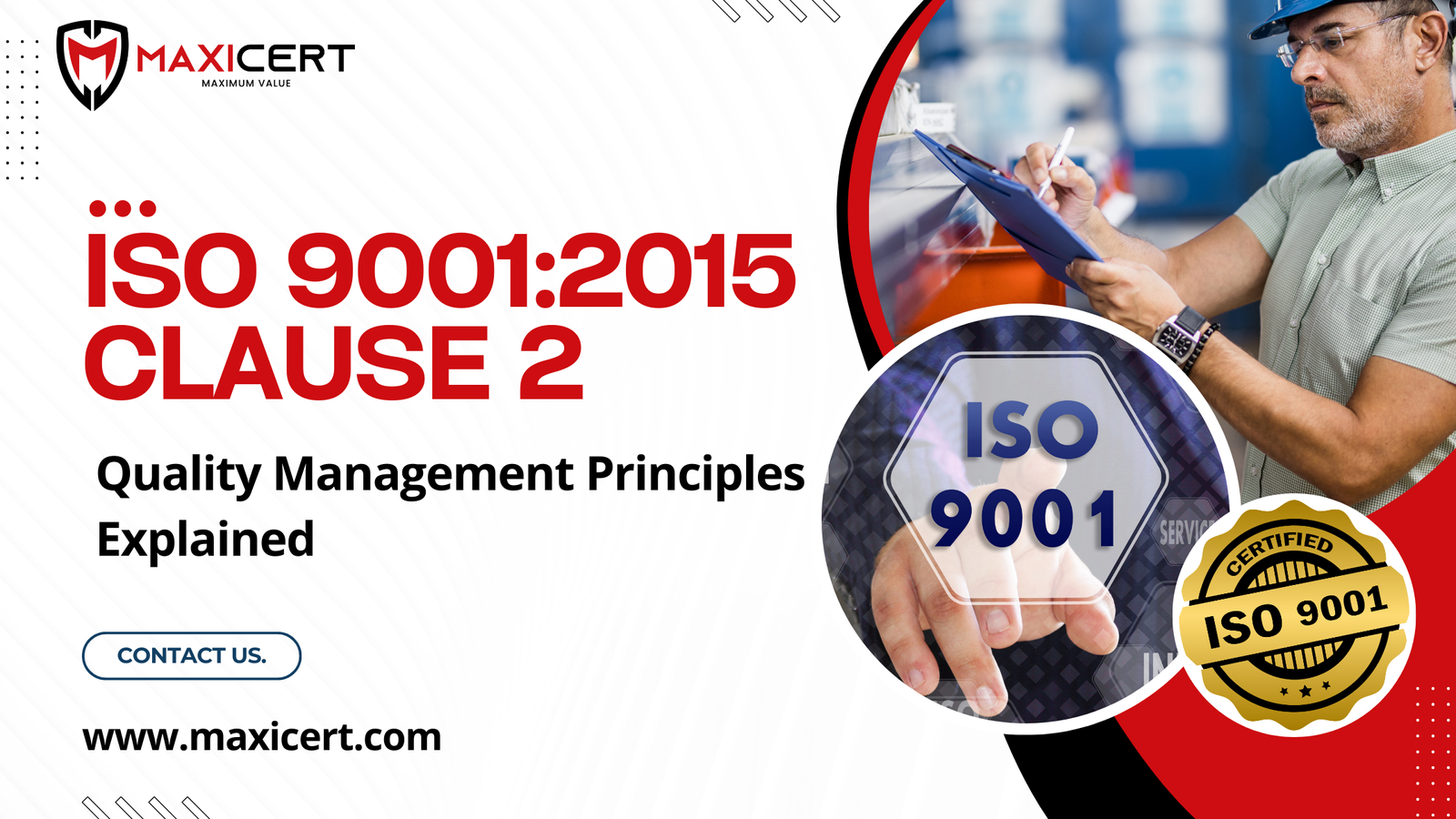ISO 9001:2015 Clause 2 – Quality Management Principles Explained
Introduction
ISO 9001:2015 is based on a strong foundation of quality management principles (QMPs), which offer an organizational framework for sustained success. Clause 2 of the standard presents these principles, which were derived from ISO 9000 and developed by international experts of ISO/TC 176.
These principles are not merely theoretical precepts, they are best practices used globally by organizations looking to enhance customer trust, operational efficiency, and sustainable growth.
Here, ISO identifies seven principles of quality management, each with a rationale, benefits, and recommended actions for organizations to integrate them in their management systems.

The seven principles are:
- Customer Focus
- Leadership
- Engagement of People
- Process Approach
- Improvement
- Evidence-based Decision Making
- Relationship Management
Let’s look at each principle in detail.
Explore how Maxicert can help your organization implement ISO 9001:2015 effectively
QMP 1 – Customer Focus
The primary focus of quality management is to meet customer requirements and to strive to exceed customer expectations.
- Sustained success is achieved when an organization attracts and retains the confidence of customers and other interested parties on whom it depends.
- Every aspect of customer interaction provides an opportunity to create more value for the customer.
- Understanding current and future needs of customers and other interested parties contributes to sustained success of an organization.
QMP 2 – Engagement of People
It is essential for the organization that all people are competent, empowered, and engaged in delivering value.
Competent, empowered, and engaged people throughout the organization enhance its capability to create value.
To manage an organization effectively and efficiently, it is important to involve all people at all levels and to respect them as individuals. Recognition, empowerment, and enhancement of skills and knowledge facilitate the engagement of people in achieving the objectives of the organization.
ISO 9001:2015 Clause Guide Panel
- Clause 1
- Clause 2
- Clause 3
- Clause 4 – Sub-clause 1
- Clause 4 – Sub-clause 2
- Clause 5 – Sub-clause 1
- Clause 5 – Sub-clause 2
- Clause 5 – Sub-clause 3
- Clause 6 – Sub-clause 1
- Clause 6 – Sub-clause 2
- Clause 7 – Sub-clause 1
- Clause 7 – Sub-clause 2
- Clause 7 – Sub-clause 3
- Clause 7 – Sub-clause 4
- Clause 8 – Sub-clause 1
- Clause 8 – Sub-clause 2
- Clause 8 – Sub-clause 3
- Clause 8 – Sub-clause 4
- Clause 8 – Sub-clause 5
- Clause 8 – Sub-clause 6
- Clause 8 – Sub-clause 7
- Clause 8 – Sub-clause 8
- Clause 8 – Sub-clause 9
- Clause 8 – Sub-clause 10
- Clause 8 – Sub-clause 11
- Clause 8 – Sub-clause 12
- Clause 9 – Sub-clause 1
- Clause 9 – Sub-clause 2
- Clause 9 – Sub-clause 3
- Clause 9 – Sub-clause 4
- Clause 10
QMP 3 – Leadership
Leaders at all levels establish unity of purpose and direction and create conditions in which people are engaged in achieving the quality objectives of the organization.
Why it matters:
Without leadership, even the best processes fail. Leaders set the vision, inspire people, and align resources with organizational objectives. Strong leadership ensures that policies and strategies are consistently applied across the business.
Benefits:
- Clear direction for employees
- Alignment of organizational strategies
- Increased accountability and trust
Typical actions:
- Communicating vision and values across the organization
- Encouraging open communication
- Creating a culture of trust and collaboration
QMP 4 – Process Approach
Consistent and predictable results are achieved more effectively and efficiently when activities are understood and managed as interrelated processes that function as a coherent system.
The quality management system is composed of interrelated processes. Understanding how results are produced by this system, including all its processes, resources, controls, and interactions, allows the organization to optimize its performance.
QMP 5 – Improvement
Successful organizations have an ongoing focus on improvement.
Why it matters:
Markets evolve, customer expectations change, and technology advances. Organizations that fail to improve stagnate and lose relevance. Improvement should not be treated as a one-time activity but as a culture.
Benefits:
- Adaptability to changes in the business environment
- Enhanced efficiency and reduced waste
- New opportunities for growth and innovation
Typical actions:
- Establishing measurable improvement objectives
- Regularly reviewing performance and identifying gaps
- Encouraging employees to suggest improvements
ISO 9001:2015 Quality Management Principles
Explore six key principles that drive organizational success under ISO 9001:2015.
Customer Focus
Understanding and meeting customer needs to ensure long-term success.
Leadership
Strong leadership sets direction and builds alignment within the organization.
Engagement of People
Empowering and involving people at all levels for better results.
Process Approach
Managing activities and resources as processes to achieve efficiency.
Improvement
A culture of continual improvement drives organizational performance.
Evidence-Based Decisions
Making decisions based on data and analysis to reduce risks.




